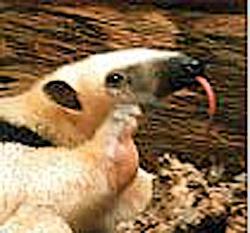
|
 The Tamandua or Collared Anteater

 Belize is a spectacular country rich in
teeming jungles, lush rainforests, dry pine
savannas, tangled mangrove swamps,
and dynamic coral reefs. It’s home to
countless species of wildlife and creatures
that inhabit the terrain including The
Tamandua or Collared Anteater
(tamandua mexicana). This diurnal and
nocturnal, arboreal, terrestrial and solitary
creature can be found in Central and
South America; from the south of Mexico
throughout all of Central America including
Belize. It feeds mainly on ants, termites,
and bees extracted after ripping
apart their nests with their fore claws.
Belize is a spectacular country rich in
teeming jungles, lush rainforests, dry pine
savannas, tangled mangrove swamps,
and dynamic coral reefs. It’s home to
countless species of wildlife and creatures
that inhabit the terrain including The
Tamandua or Collared Anteater
(tamandua mexicana). This diurnal and
nocturnal, arboreal, terrestrial and solitary
creature can be found in Central and
South America; from the south of Mexico
throughout all of Central America including
Belize. It feeds mainly on ants, termites,
and bees extracted after ripping
apart their nests with their fore claws.

Tamanduas can be seen foraging on the ground or in the canopy anywhere in the
forest, but most commonly, at watercourses, where their prey may be concentrated. |
They have an average body size of 60
cm (23 inches); its tail would range as
long as 50 cm (19 inches) and average a
body weight of 6 kilograms (13lbs).
Tamanduas are medium sized, with a
long prehensile tail. It has distinctive colors;
blonde on the head, upper back and
legs, with a black vest, or entirely blonde,
or blonde with a partial vest. It has four
large claws on its powerful forelimbs,
five claws on hind limbs and the tail is
almost naked, pink with irregular blackish
splotches. Tamanduas can be seen foraging
on the ground or in the canopy anywhere
in the forest, but seem most common
beside watercourses, where their
prey may be concentrated. By day in the
rainforest a dense cloud of flies and mosquitoes
accompanies them so they often
brush their eyes with a forepaw. When
inactive, tamanduas rest in hollow trees,
burrows of other animals or other natural
shelters. Their local names are: Oso
Hormiguero, Tamanduá, Susurete, Oso
Amarillo, Brazo Fuerte, Oso Mielero
in Spanish, ant bear in Belize and in
Mayan it is called Chab.
You wouldn’t think that a diet of only
ants and termites could keep large animals
happy, but the tropical anteaters like
the tamanduas have figured out a successful
strategy. Much like large bears
can feed themselves by regularly visiting
known berry patches, tamanduas return
to the same ant and termite nests
again and again to feed from the larvae
found deep within. To the tamanduas,
these small insects are a reliable food
source which, although they seem small
and non-nutritious to you and me, can
support these handsome anteaters thanks
to their many special adaptations.

The most conspicuous distinctive mark
of all Anteater species is their long
snout and their extremely long tongue,
the average tongue ranges from 20 to
23 inches in length. |
Tamanduas are mammals of the ancient
order Xenarthra, which includes animals
with very simple teeth or, as in the case
of the tamanduas, no teeth at all. The
tamanduas all have strong, muscular
stomachs capable of grinding the ants they
eat, instead of chewing them. Tamanduas
show remarkable skill at capturing
ants, thanks to their powerful front legs
and sturdy claws that allow them to tear
into ant nests and termite mounds, into
which they jam their long snout and put
to work their famous tongues. All anteaters
have extremely long tongues, some
up to 60 centimeters (23 inches) long!
Equipped with backwards pointing hairs,
and coated with gooey saliva, the tongue
is used to scoop up ants and termites from
inside the nest, and especially their larvae.
The tongue is then pulled back into
the snout covered with ants which are
then swallowed.
Since many ants and termites in the
tropics live high in the trees, most
tamanduas are adapted to an arboreal
lifestyle, although they will spend considerable
time on the ground if ants and
termites are more abundant there. Arboreal
tamanduas are equipped with a
strong prehensile tail that grabs vines and
branches while they climb and helps hold
them in place as they use their front legs
to tear open the nests of their prey. Because
of their heavy claws, anteaters
have had to devise a different way of
walking when on the ground, where they
lope along using specialized pads on the
sides of the paws. Although they are normally
slow moving, conserving their energy
as they forage, they can run at surprising
speeds when frightened. In the
trees, their prehensile tail and the special
shape of their paws (which has a
central fold permitting them to grasp narrow
vines) allows them to move easily
and noiselessly through the forest canopy.
Little is known of reproduction in
Tamanduas; they mate in the fall and give
birth to a single young in the spring. Births
of twins have also been recorded. Females
are polyestrous (ovulating more
than once a year), with a gestation period
of either 130 to 150 days or 160 to
190 days. They will set their young on a
tree branch when feeding. Anteaters
spend a lot of time teaching their young
how to live off this specialized diet. Female
tamanduas only give birth to a single
offspring, which accompanies the mother
for many months, riding on her back and
clinging tightly to her fur. The youngster
gradually learns the techniques for finding
nests, tearing them open, sucking the
ants and larvae from inside, withdrawing
once defensive soldiers appear, and
maintaining a map of feeding sites that it
has visited. Because of this lengthy period
of maternal care, tamanduas do not
have high rates of reproduction, and are
ill-suited to withstand the pressures of
hunting and deforestation. Although they
can be quite abundant in good habitat, they
are infrequently seen by visitors to the tropics. Shy, they often flee at the sound
of humans, or they may hide quietly on a
tree branch high over your head. However,
signs of their presence are common;
by day, look for ant and termite
nests with rough, large holes excavated
in the sides, by night, listen carefully for
the sound of dirt raining out of the treetops
and striking the forest floor. This
characteristic clue of a tamandua at work
ripping into an ant nest is one of the most
reliable methods scientists use to find anteaters
in order to study them. This unique
creature and its friends can be seen at
the Belize zoo or if you are lucky, you
can spot one in the hidden hallows of the
rainforests.
tropics. Shy, they often flee at the sound
of humans, or they may hide quietly on a
tree branch high over your head. However,
signs of their presence are common;
by day, look for ant and termite
nests with rough, large holes excavated
in the sides, by night, listen carefully for
the sound of dirt raining out of the treetops
and striking the forest floor. This
characteristic clue of a tamandua at work
ripping into an ant nest is one of the most
reliable methods scientists use to find anteaters
in order to study them. This unique
creature and its friends can be seen at
the Belize zoo or if you are lucky, you
can spot one in the hidden hallows of the
rainforests.
Click here to return to the main page for Caribbean Critters
|


 Belize is a spectacular country rich in
teeming jungles, lush rainforests, dry pine
savannas, tangled mangrove swamps,
and dynamic coral reefs. It’s home to
countless species of wildlife and creatures
that inhabit the terrain including The
Tamandua or Collared Anteater
(tamandua mexicana). This diurnal and
nocturnal, arboreal, terrestrial and solitary
creature can be found in Central and
South America; from the south of Mexico
throughout all of Central America including
Belize. It feeds mainly on ants, termites,
and bees extracted after ripping
apart their nests with their fore claws.
Belize is a spectacular country rich in
teeming jungles, lush rainforests, dry pine
savannas, tangled mangrove swamps,
and dynamic coral reefs. It’s home to
countless species of wildlife and creatures
that inhabit the terrain including The
Tamandua or Collared Anteater
(tamandua mexicana). This diurnal and
nocturnal, arboreal, terrestrial and solitary
creature can be found in Central and
South America; from the south of Mexico
throughout all of Central America including
Belize. It feeds mainly on ants, termites,
and bees extracted after ripping
apart their nests with their fore claws.


